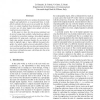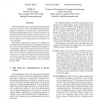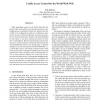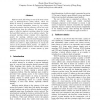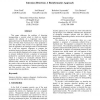ACSAC
2003
IEEE
14 years 5 months ago
2003
IEEE
Over the past decade, Intrusion Detection Systems (IDS) have improved steadily in the efficiency and effectiveness with which they detect intrusive activity. This is particularly ...
ACSAC
2003
IEEE
14 years 5 months ago
2003
IEEE
General-purpose operating systems provide a rich computing environment both to the user and the attacker. The declining cost of hardware and the growing security concerns of softw...
ACSAC
2003
IEEE
14 years 5 months ago
2003
IEEE
Tapping into the communication between two hosts on a LAN has become quite simple thanks to tools that can be downloaded from the Internet. Such tools use the Address Resolution P...
ACSAC
2003
IEEE
14 years 5 months ago
2003
IEEE
Digital signatures allow us to produce documents whose integrity and authenticity, as we generated them, is verifiable by anybody who has access to our public key. Furthermore, w...
ACSAC
2003
IEEE
14 years 5 months ago
2003
IEEE
This paper reports an experiment aimed at generating synthetic test data for fraud detection in an IP based videoon-demand service. The data generation verifies a methodology pre...
ACSAC
2003
IEEE
14 years 5 months ago
2003
IEEE
Understanding the nature of the information flowing into and out of a system or network is fundamental to determining if there is adherence to a usage policy. Traditional methods...
ACSAC
2003
IEEE
14 years 5 months ago
2003
IEEE
While publishing content on the World Wide Web has moved within reach of the non-technical mainstream, controlling access to published content still requires expertise in Web serv...
ACSAC
2003
IEEE
14 years 5 months ago
2003
IEEE
Reflector attack [9] belongs to one of the most serious types of Denial-of-Service (DoS) attacks, which can hardly be traced by contemporary traceback techniques, since the marked...
ACSAC
2003
IEEE
14 years 5 months ago
2003
IEEE
As computer infrastructures become more complex, security models must provide means to handle more flexible and dynamic requirements. In the Organization Based Access Control (Or...
ACSAC
2003
IEEE
14 years 5 months ago
2003
IEEE
This paper addresses the problem of detecting masquerading, a security attack in which an intruder assumes the identity of a legitimate user. Many approaches based on Hidden Marko...

